This post will focus on three components of marketing theory that I find particularly interesting:
- The “big debate in marketing” – segmented vs mass-market approaches
- What are the benefits of market orientation and how to adopt one
- The evolution and future of marketing
1. The big debate: segmented vs mass-market approaches
Established marketing theory argues strategy should be based on:
- Segmentation
- Targeting
- Positioning and differentiation
Put simply: Identify your niche, understand their pain points, and position yourself in a way that is attractive to them.
But nothing is ever that simple… Another school of thought argues the exact opposite – namely, that mass-market approaches targeting the “total available market” are more effective than going after niche segments.
Instead of differentiating yourself, they argue you should seek to create a distinctive quality to your brand, making a memorable impression via emotional priming. In this way, you increase “salience” – the mental availability within the mind of a customer.
This view has been popularised in Byron Sharp’s “How brands grow”, which includes the following table comparing these two opposing marketing philosophies.
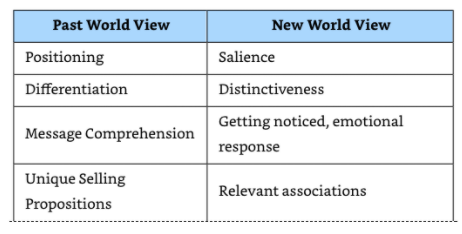
So, we have two diametrically opposed theories: targeting a niche segment with a differentiated proposition versus seeking a distinctive, emotional connection with as many people in the market as possible. This debate is raging in the board rooms of many major brands right now.
How do we make sense out of these seemingly contradictory theories?
Enter the work of Binet and Field… Conducting research on data from the IPA databank, their analysis looked at over 1,000 advertising campaigns across 30 years. What they found reconciles these two opposing positions.
Targeting niche segments with a logical proposition should be used in the short term to drive sales activation. But if you exclusively focus on sales, your pipeline will dry up. Therefore, you should simultaneously invest in long-term brand-building campaigns to build an emotional connection with your audience. The relationship between the two can be seen below:
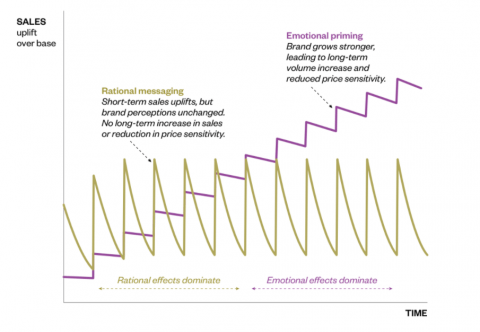 Binet and Field went on to propose budget breakdowns based on what their research showed. They proposed 60% of your budget should be spent on brand building and 40% on sales activation.
Binet and Field went on to propose budget breakdowns based on what their research showed. They proposed 60% of your budget should be spent on brand building and 40% on sales activation.
This is summarised in the table below, which brings together both STP and mass-market approaches within Field and Binet’s framework.

What about B2B?
A common thought about emotion-led brand-building campaigns is that it only works well for B2C brands with big marketing budgets. In my view, this myth is based upon a notion that B2B buyers are some sort of automatons, making entirely rational purchasing decisions based on rigid selection criteria.
I am sure it is no shock to state that B2B buyers are just as human as normal consumers and therefore are similarly motivated by unconscious emotional drivers.
Binet and Field demonstrated this point in their recent research that looked specifically at B2B marketing. They found that the importance of emotion in B2B decision making was significant and only marginally less than in B2C (42% in B2C and 35% in B2B).
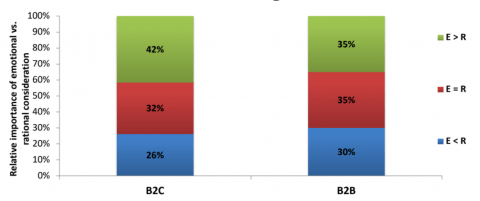
For many companies, this means a gradual shift in budget choices, moving away from short-term sales activity to long-term brand building. This sacrifice is only short-term, as the research demonstrates that after 6 months, your efforts in brand begin to reap dividends that will outstrip sales activity alone.
Understandably, it can be difficult for marketers to convince the C-suite of investing in brand building, which is often seen as less tangible. But marketers may have a more difficult battle on their hands if they want to maximise the impact marketing can have on their organisations.
2. What is market orientation and what are the benefits?
The main reason that marketing teams fail is actually nothing to do with the marketing team’s performance. It is organisational cultures that are typified by naval gazing – an excessive internal focus.
What does this cultural failure have to do with marketing? Well, marketing has been defined as “the achievement of business goals through exceeding the needs of the customer“.
Most marketing teams are seen as an adjunct to business operations. They may succeed in achieving the first part of the definition “achieving business goals”, but too often they fail at the second part, “exceeding the needs of the customer”.
This failure is ubiquitous and isn’t the fault of marketing teams. Organisations must pivot their focus away from internal issues, completely reorienting themselves around customer’s needs.
What is market orientation?
A company can have 5 different orientations:
- Product orientation
- Sales orientation
- Production orientation
- Societal orientation
- Market orientation
Market orientation brings marketing out of the marketing department. It means that the company has a complete understanding of its markets and customers. Customer information permeates all functions and strategic decisions are made inter-functionally, where potential conflicts between departments are ameliorated in the service of the customer’s needs.
The components of market orientation can be seen below:
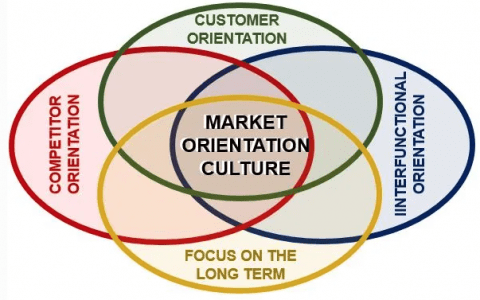
The challenge to achieving customer focus is a natural tendency to obsess over internal matters, such as process, profit, or product. To counter this, marketing teams need to convince senior leadership of the value of market orientation. Senior leaders, together with marketing teams, must then lead company-wide efforts to focus all departments on the needs of the customer, breaking down interdepartmental barriers.
This is the essence of “market orientation” – marketing not as a function, but as a strategic, company-wide orientation focused on identifying and fulfilling the needs of your customer.
Benefits of a market orientation
So why adopt this approach? There is a significant amount of evidence that demonstrates a positive relationship between market orientation and company performance. This includes increased customer satisfaction, ability to adapt to dynamic market forces, and bottom-line performance.
How do I adopt a market orientation?
The first thing to do is conduct a market orientation audit. This calculator has 20 simple questions that will help you understand how strongly oriented towards the market your company is. The questions also act as a checklist for becoming more market-oriented.
The calculator is a simple Google Sheet that you can copy. We have repurposed it from “Marketing strategy and competitive positioning” by Graham Hooley.
Societal Marketing Concept
A societal market orientation builds on the tenets of market orientation, adding that organisations should also orient themselves around the needs of society at large. In contrast to shareholder capitalism, it argues that long-term success is predicated upon balancing the needs of multiple stakeholders; customers, employees, shareholders, the community, and the planet.
 I believe that the coalescence of disruptive forces such as the Covid-19 pandemic, rapid technological advancement, and the accelerating climate crisis, will lead to more organisations setting goals around social impact, as well as profit and customer goals.
I believe that the coalescence of disruptive forces such as the Covid-19 pandemic, rapid technological advancement, and the accelerating climate crisis, will lead to more organisations setting goals around social impact, as well as profit and customer goals.
Interestingly, this is also what your customers want to see. 76% of people agree that the pandemic has made them more sympathetic towards the needs of others in their community and are inspired to take positive action (Source = Deloitte Millennial Survey).
Increasingly, buyers are considering ethics and value alignment to be important in their purchasing decisions, which can be seen in the statistics below (Source = 5W customer research).
- 71% of consumers prefer buying from brands that align with their values
- 83% of millennials look for value alignment in purchases
- 62% of millennial buyers buy from companies that support their political and social beliefs
Regardless of whether you want to set social impact goals for your organisation, what is difficult to deny is that infusing customer-centricity throughout your organisation will result in superior customer satisfaction, and ultimately, better organisational performance.
3. The Evolution and Future of Marketing
To make predictions on the future of marketing, it is useful to observe how marketing has evolved over the decades.
In nascent form, “marketing” emerged in the 16th century as a basic description of market transactions. What we now consider as “modern marketing” can be traced to the industrial revolution, where the need to promote mass-produced products was dramatically expanded.
Between the 1950s to 1970s, marketing became a serious field of study, focusing on the techniques of “how to do” marketing. This is when much of the material you are taught in A-level business was formulated – market audits, micro and macro environments, the 4Ps, PESTLE analysis, and segmentation, targeting, and positioning.
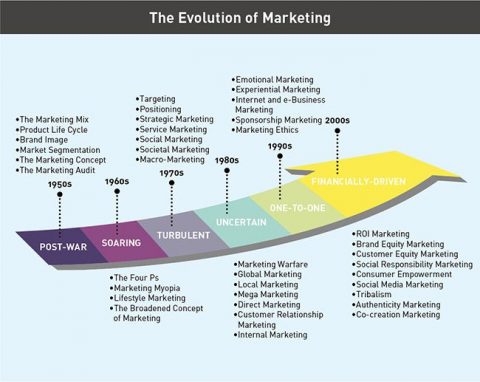
The evolution of marketing is driven by two main factors:
- Technological advancement
- Changing demands of the customer
With the advent of the internet, the measurability of marketing significantly increased. The quote “half the money I spend on advertising is wasted; the trouble is, I don’t know which half” has been rendered largely redundant.
Sophisticated attribution modeling allows advertisers to assign value to different touchpoints in the customer’s journey. Google’s machine learning allows advertisers to engage specific audiences with specific interests, intents, and demographics. By predicting the items buyers are looking for, marketing effectiveness has skyrocketed. This is the era of financially driven, ROI marketing where performance-based marketing methods have flourished.
Until now…
The future of marketing
Just as previous evolutions of marketing were driven by changes in technology, so is the current paradigm shift. As individuals become more concerned with privacy, legislative changes like GDPR and CCPA are tightening controls on how data is stored and processed.
The shift in the legal, political, and societal landscape is prompting a reaction from the tech giants. Apple now requires opt-in tracking in iOS14 and Google is also on the path to deprecating third-party cookies. . Where marketers previously relied on big tech companies to track users around the internet, marketers must do their own first-party data collection.
As the technological shortcuts that marketers have enjoyed begin to become less effective, I predict a resultant resurgence in traditional marketing methodologies. To thrive in this new era, digital marketers will need to become more well-rounded. Those who have grounded their technical knowledge in solid strategic foundations will thrive. We need to wean ourselves off the addiction to third-party data and harness the power of creativity to make real connections with our audiences.
And all of this should take bottom-line performance to be one goal amongst many. In this time of disruption, we have a chance to reinvent ourselves by adopting a societal market orientation. The business community has an opportunity to redefine our purpose, setting goals that serve all our stakeholders – our customers, our staff, our shareholders, our community, and our planet.
Keep an eye out for the next module in the series, but if you have any questions, don’t hesitate to get in touch.









